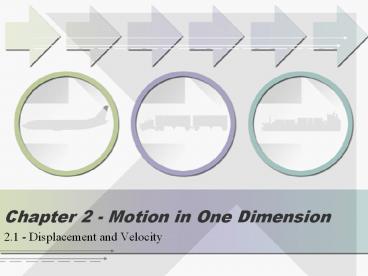Chapter 2 - Motion in One Dimension - PowerPoint PPT Presentation
1 / 36
Title: Chapter 2 - Motion in One Dimension
1
Chapter 2 - Motion in One Dimension
- 2.1 - Displacement and Velocity
2
Motion
- One-dimensional motion is the simplest form of
motion - e.g. a train on a straight track (forward or
backward) - In this chapter we will consider only
one-dimensional motion
3
Motion
- The first step in analyzing motion is to choose a
frame of reference. - If an object is at rest, its position does not
change with respect to a frame of reference. - When we choose this frame of reference, we need
to remember to remain consistent.
4
Displacement
- Displacement is the change in position of an
object. - It is the length of the straight line drawn from
its initial position to its final position
Displacement change in position final
position - initial position
5
Displacement
- Displacement is not always equal to the distance
traveled
6
Displacement
- Displacement can be positive or negative
7
Average Velocity
- Knowing the distance traveled or the displacement
doesnt tell completely describe the motion of an
object - Knowing the speed is important for evaluating
motion - Average velocity is the total displacement
divided by the time interval during which the
displacement occurred
8
Average Velocity
- The Average Velocity can be positive or negative
- Equal to the constant velocity needed to cover
the given displacement in a given time interval - It is NOT the average of the starting and ending
velocities - Example A car travels from city A to city B (100
km). If the first half of the distance is driven
at 50 km/h and the second half is driven at 100
km/h, what is the average velocity of the car?
9
Practice
- Page 44, Practice 2A
10
Average Speed
- Velocity is not the same as speed
- Velocity has both magnitude AND direction
- Speed has only a magnitude
11
Graphical Interpretation of Velocity
- In a position-time graph, we can determine the
vavg by drawing a straight line between two
points on the graph
12
Graphical Interpretation of Velocity
13
Instantaneous Velocity
- The velocity of an object at some instant
14
Chapter 2
- Section 2.2 - Acceleration
15
Acceleration
- Most objects in motion dont move with a constant
velocity - Acceleration measures the rate of change in
velocity in a given time interval
16
Problem
- Find the acceleration of an amusement park ride
that falls from rest to a speed of 28m/s in 3.0s. - 9.3 m/s2
17
Acceleration
- Acceleration has both magnitude and direction
- If an object (i.e. a car) is moving in the
positive direction and is speeding up, the
acceleration is positive - If an object is moving in the positive direction
and is slowing down, the acceleration is negative - If an object (i.e. a car) is moving in the
negative direction and is speeding up, the
acceleration is negative - If an object is moving in the negative direction
and is slowing down, the acceleration is positive
18
Constant acceleration
- The slope of a velocity-time graph gives the
acceleration - When acceleration is constant, the velocity is
increased by the same amount during each time
interval. - The displacement for each time interval increases
by the same amount
19
Displacement
- Depends on
- Initial velocity
- Acceleration
- Time
When acceleration is constant, Vavg is the
average of Vi and Vf
20
Displacement
- When acceleration is constant
21
Displacement
- The area under the curve in a graph of velocity
versus time equals the displacement during the
time interval
22
Problem
- A bicyclist accelerates from 5.0 m/s to a
velocity of 16 m/s in 8 s. Assuming uniform
acceleration, what distance does the bicyclist
travel during this time interval? - 84m
23
Final Velocity
- Depends on
- Initial velocity
- Acceleration
- Time
24
Constant Acceleration
25
Displacement with constant uniform acceleration
26
Final velocity after any displacement
Remember that the square root may be either
positive or negative
27
Problem
- An aircraft has a landing speed of 302 km/h. The
landing area of an aircraft carrier is 195 m
long. What is the minimum uniform acceleration
required for a safe landing? - -18.0 m/s2
28
Summary
29
HW Assignment
- Page 49, Practice 2B, 1 and 4
- Page 53, Practice 2C, 3 and 4
- Page 55, Practice 2D, 2 - 4
- Page 58, Practice 2E, 2, 5, 6
30
Chapter 2
- Section 2.3 - Falling Objects
31
Free Fall
- Motion of an object falling with a constant
acceleration - In the absence of air resistance all objects
dropped near the surface of a planet fall with
the same constant acceleration - The symbol for free-fall acceleration is g
- At the surface of the earth, the magnitude of g
is approximately 9.81 m/s2.
32
Free Fall
- This acceleration is directed downwards
- a -g -9.81 m/s2
- What goes up, must come down
- Fig 2-15, pg 61
- Initial velocity of 10.5 m/s, acceleration is
-9.81 m/s2 - After 1 s, v 0.69 m/s, acceleration is
-9.81m/s2 - After 2 s, v -9.12 m/s (directed downward), a
9.81 m/s2
33
Free Fall
34
Free Fall
- FREELY FALLING OBJECTS ALWAYS HAVE THE SAME
DOWNWARD ACCELERATION
35
Problem
- A ball is thrown straight up into the air at an
initial velocity of 25.0 m/s. Create a table
showing the balls position, velocity, and
acceleration each second for the first 5.00 s of
its motion. - Find the balls time, position, velocity, and
acceleration at the top of its flight
36
HW Assignment
- Pages 72 - 75 34, 38, 40, 41, 46, 50, 56































